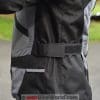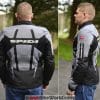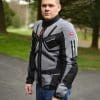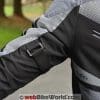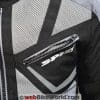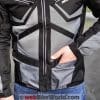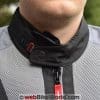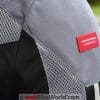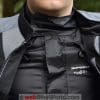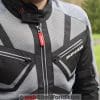The new Spidi Ventamax mesh jacket is a summer version of the Spidi Multiwinter H2Out jacket. Both have what we call a 5/8 length. It’s slightly longer than your typical short mesh jacket but not quite 3/4-length. Goldilocks would like it — not too short, not too long, but just right! Spidi calls this an enduro adventure mesh summer jacket and that’s a pretty good description.
The Ventamax has typical Spidi attention to detail and quality with European styling. Spidi says the Ventamax is 50% mesh, which gives it plenty of ventilation. This is a fairly light weight jacket however, so keep that in mind. It’s the compromise you’ll have to make to get a summer jacket for riding in hot weather.
The impact points are covered in a lightweight solid fabric but we’re a bit concerned about the single rows of stitching holding it together. Also, there’s just a single row of stitching and that runs down the center of the sleeve, over the elbow. We dinged the AGV Sport Torino jacket (review) for that issue and we have the same concerns with the Ventamax.
Nevertheless, the jacket feels light, airy and comfortable and it probably has more protection than you’ll get from most all-mesh types. Also included is a Spidi “H2Out” waterproof and breathable liner that has an odd-shaped neck, as we will see. Stuff the liner in your tank bag (the Ventamax has no rear pouch) for emergency use only or when you get caught out by a cooler-than-expected summer night.
The 5/8 length yields good coverage without giving it the clumsy 3/4-length look and the Ventamax comes in all black, the black/gray shown here or black/gray/yellow variant. It has that “European” fit though, complete with slim arms, so sizing may be a problem for “American normal” body types. Genuine EN1621-1 certified “Forcetech” elbow and shoulder protectors are included and you’ll want to add an optional Spidi “Warrior” Level 1 or 2 back protector.
One more thing: the Ventamax seems very expensive for what it is. However, it looks good and it’s hard to beat in hot weather. But will summer ever arrive?
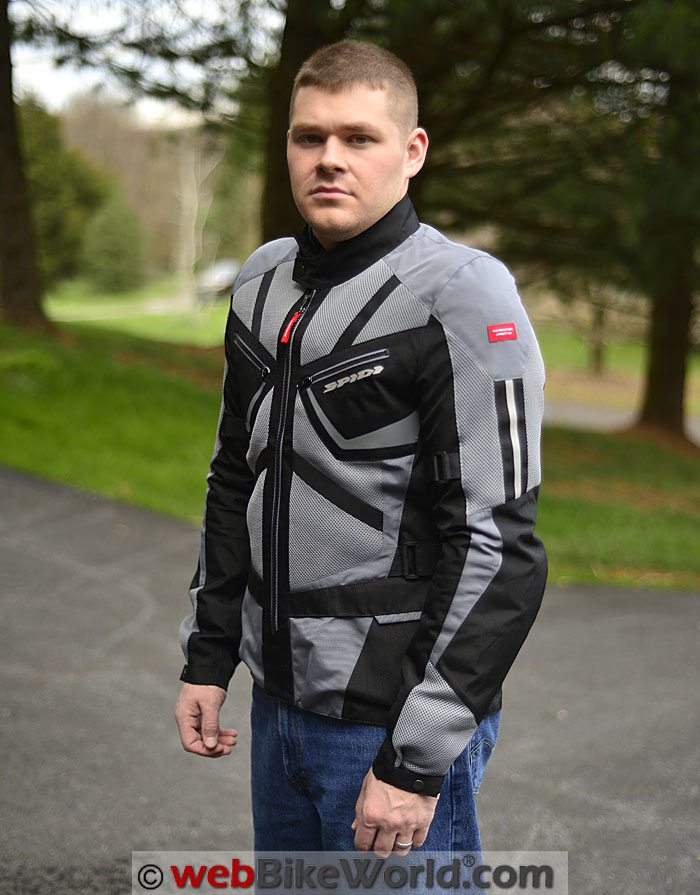


Introduction
The Spidi Ventamax H2Out jacket is new for 2016. It’s all about the mesh on this one — or should I say that it’s all about the ventilation.
Ventamax = max ventilation. Obviously.
Does the Ventmax look familair? If you were browsing through the very extensive Spidi catalog this past winter, you may have come across the Spidi Multiwinter H2Out jacket.
The Ventamax is the summer doppelgänger of the Multiwinter — nearly identical styling but with lots of mesh surface area for hot-weather motorcycle riding.
In that regard, it works marvelously.
In the mostly cool and wet weather we’ve had here so far this spring there were only a few days warm enough for the Ventamax to show its stuff.
But those rides were enough to reveal three important facts. First, this is a light weight jacket (for better or worse) and it has a tailored fit that works best with slim body types.
Most importantly, it really does have excellent ventilation.
The 5/8 length is unusual, rarely appearing in one or two previous webBikeWorld motorcycle jacket reviews. It’s an interesting choice for a summer jacket but Spidi actually lists the Ventamax for two-season use, due to the included H2Out liner.
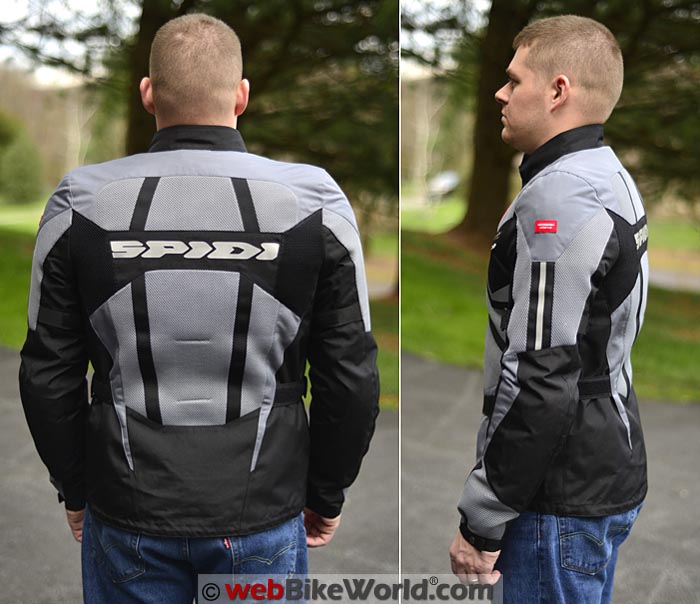


Styling and Fit Notes
Spidi is known for style and quality and the Ventamax doesn’t disappoint. The overall look is modern and somewhat angular in the current “adventure” design idiom.
Good styling should look good for a variety of uses and it should stand the test of time and we think the Ventamax does. Although Spidi sort of markets the Ventamax as an adventure-touring style, it also works for touring and even cruising.
The Ventamax also has what American motorcycle riders call a “European fit”, which means it’s cut and tailored to fit those tapered and (relatively) thin advertising models you see in the ads.
The tapered fit isn’t as extreme as European motorcycle clothing was about 15 years ago, but it does feel more “European” than “American”.
Since far too many motorcycle riders wear clothing that’s one or even two sizes too big, in addition to being too bulky and baggy, the slim fit of the Ventamax isn’t necessarily an issue.
Proper motorcycle clothing isn’t supposed to be designed for comfortable couch lounging; it must fit snugly so that it doesn’t twist, pull, grab or move during a crash.
It needs to stay in place to keep the abrasion-resistant parts located correctly and to prevent the protectors from moving. This is doubly true for a mesh jacket because mesh typically has less support than solid fabric (more on that in a bit).
But the jacket also has to be cut so that the wearer can operate the motorcycle with ease.
To meet these objectives, the garment must have a combination of proper tailoring and intelligent design and construction of the various fabric panels.
This is what you get when you pay a little extra for good quality motorcycle clothing versus the cheap stuff. But the more tailored the fit, the narrower the range of riders who will, well, fit.
Sizing
Actually, I’m not complaining. The Ventamax jacket does fit me, fortunately. The sizing seems to run about about one size small, compared to all of the other jackets we have reviewed.
This Ventamax is a size XL and it fits more like a snug size large. On the other hand, the size XL seems to be about the equivalent of a European size 54 and in Europe, a 54 is an XL.
The body of the jacket is nicely tapered but the biggest (smallest?) issue for many will be the sleeves, which have smaller diameter than expected.
None of us here have anything like weightlifter biceps, but the Ventamax does feel a bit tight around the upper arms, so the upper arm adjusters won’t be needed for most owners.
Actually, the arms feel fine until the elbows are bent; that’s when the sleeves start to tighten. This is exacerbated a bit because the jacket could use some pleats in the rear to give some extra stretch room across the back as the arms move into the riding position.
All of this means that if you fit the Ventamax — and if the Ventamax fits you — it meets the “snug is protective” criteria described in the previous section. But this will probably work only for those with the so-called “ideal” body type.
Others may find that they have to move up as many as two sizes to find a Ventamax that fits.
The model shown in the photos has about a 44″ chest and 35″ waist and he’s in good shape. He normally fits most of the L or XL jackets that we review, but you can see this size XL Ventamax fits pretty tightly across the upper chest and shoulders.
Mesh vs. Abrasion and Impact Resistance
The Ventamax has plenty of very nice, “3D” style mesh, arranged in panels where they’ll do the most good.
Since mesh doesn’t have the structure of solid fabric, the key to the Ventamax styling is the way the solid fabric sections hold the mesh to prevent it from sagging.
You can see that in the angled black lines on either side at the upper chest and the semi-horizontal sections below the chest pockets. Also in the vertical black lines of solid fabric in the rear.
These all work very nicely to give the jacket a good tailored shape and also to prevent mesh sag. It’s a very good design.
The impact areas are protected by lightweight polyester of an undefined type and denier in the shoulders. The fabric over the elbows and along the rear of the arms feels slightly thicker.
The concern we have is with the single rows of stitching that attach the solid panels to the mesh.
There’s only a single row at the outer junction of the arm and shoulder and then there is a single row of stitching for the seam along the outside of the arm, dividing the elbow and arm into two vertical hemispheres.
This is not a good place to have a seam of any type, because chances are you’re going to land on the outside of your elbows and burst, tear and impact strength in this area must be at its maximum.
We discussed this same issue in the AGV Sport Torino jacket review and right after that review was posted, AGV Sport told us they were going to change the design to move the seam so it wasn’t located at that critical point.
We hope Spidi does the same.
Protection
Spidi doesn’t scrimp on protection in their clothing and the Ventamax has genuine CE EN1621-1 certified Spidi “Forcetech” removable protectors in the shoulders and elbows.
The protectors are of good quality and the design and tailoring of the jacket is such that the protectors don’t interfere with normal riding feel.
Spidi offers two optional back protectors for the Ventamax: the EN1621-2 certified Level 1 or the certified Level 2 “Warrior” insert.
Curiously, there’s no attachment zipper inside the Ventamax for Spidi pants.
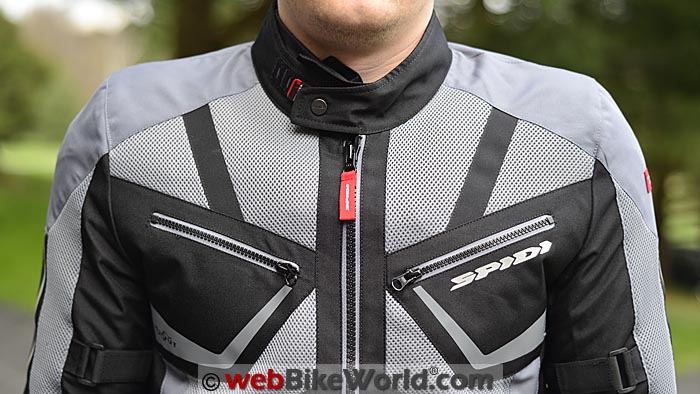


H2Out Liner
The Ventamax comes with a removable Spidi H2Out breathable membrane liner. It’s pretty thin but it does repel water. Most owners will probably ditch the liner or stow it in a tank bag or somewhere on the bike for emergency use only, however.
The jacket just doesn’t feel as comfortable with the liner installed.
For some reason, the H2Out liner doesn’t quite move smoothly against the mesh lining of the jacket, resulting in some binding. And since the sleeve fit is pretty tight anyway, the fit with the liner inserted makes the sleeves feel even tighter at the elbow.
Since the Ventamax is really a hot-weather riding jacket, perhaps Spidi should have designed an external H2Out rain shell instead, like the Held Carese II jacket we reviewed recently.
That would also keep the outer mesh shell from becoming water-soaked.
We wore the Ventamax with and without the liner and when it’s installed, it does do a good job at blocking the wind through the acres of mesh and it’s also waterproof (although you don’t want to be wearing just a T-shirt underneath or the water will make you cold).
One major issue with the liner, however, is the design of the neck. It’s just strange; it is unusually tall at 90 mm and the very thin fabric means it doesn’t “stand up” on its own.
There’s a single metal snap to hold it but the collar of the liner doesn’t really fit correctly under the jacket shell.
We noticed this right away and we had to tuck the liner collar under the jacket collar to get a decent photograph. It’s one of the reasons we pulled the liner out right away and other than for evaluation, haven’t put it back in since.
Like I said, “for emergency use only”.
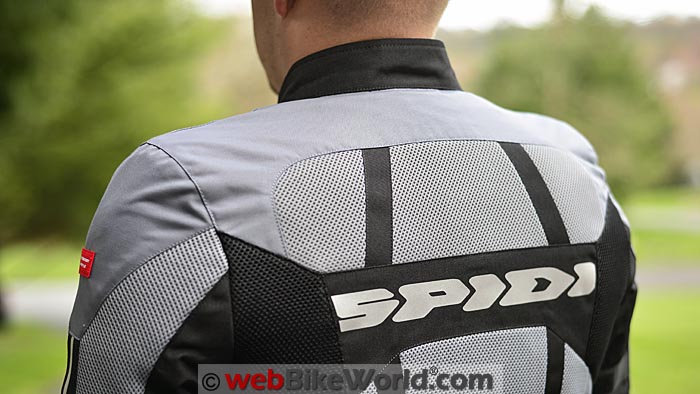


Zips and Snaps
The Ventamax has YKK brand zippers all around. The main entry zipper is a medium-sized YKK type with nylon teeth and a non-locking metal pull. The pull has a red fabric tab attached to make it easy to grasp.
The two upper chest pockets also have YKK zippers; these pockets are lined but the cover fabric is semi-permeable, which doesn’t completely prevent the air from flowing through. These are actually patch pockets, thus the back of the pocket is the mesh shell.
The two lower pockets have a single metal Prym brand snap at the outside only, so there’s no hook-and-loop or anything else for the length of the pocket flap.
None of these front pockets are waterproof, again most likely to enhance the primary function of the Ventamax, maximum ventilation.
Inside the left placket is a vertical pocket with a single plastic snap. This pocket is lined with some type of polyester taffeta so it’s not waterproof but feels like it will hold back some light rain, at least for a short period.
We wish this pocket had a zipper instead, because it’s a good place to stow your wallet when riding. There are no other pockets on the Ventamax.
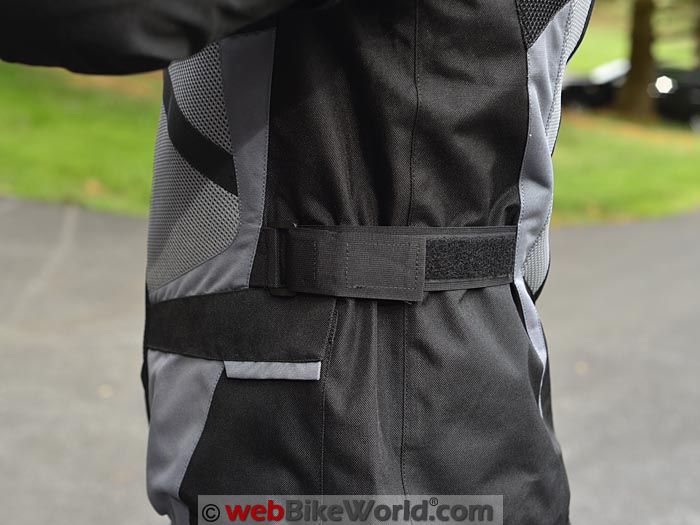

Adjustments
In addition to the upper sleeve adjusters (hook-and-loop pull type), the Ventamax has hook-and-loop belt adjusters at the waist.
Unless you have pipe-stem arms (or if your Ventamax is oversized), you probably won’t be using the arm adjusters. But the waist adjusters work nicely and help to keep the 5/8 length close to the body.
Note that they only adjust in, not out, so you won’t be able to get more gut room by letting out the adjusters.
The 5/8 jacket length helps the Ventamax to cover your waist and a portion of your seat, which is actually more comfortable than a short jacket, which can ride up as you’re leaned forward.
The hem of the jacket has elastic line with two adjusters and this helps keep the jacket controlled along the bottom also.
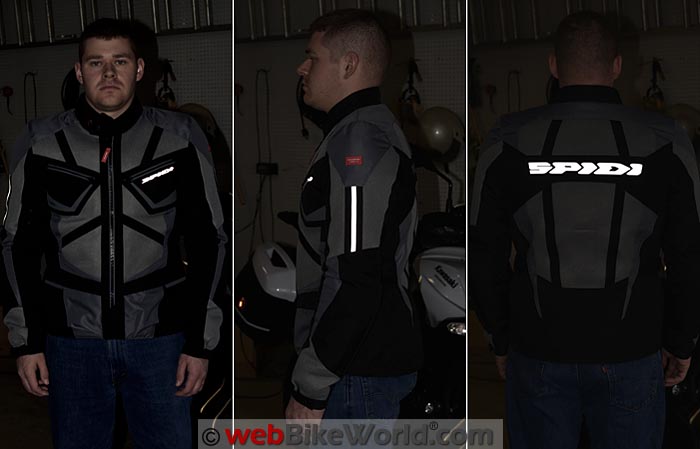


Cuffs
The Ventamax sleeve cuffs are rather simple, with one metal snap for “home” attachment of a short tab and one more snap for a tighter adjustment.
And More…
There are a few splashes of reflective material on the jacket, in the front and rear and also with the “Spidi” logos.
The collar has the clever Spidi “EST” closure for adjustment. It’s a separate hook-and-loop piece (don’t lose it!) that can be moved back or forth on the matching hook-and-loop on the jacket shell.
Then you snap the left side of the collar on to a snap on the attached hook-and-loop strip. It works well and it’s a nice low-profile solution.
Pricing
To be dead honest, we think Spidi is a bit too optimistic in pricing the Ventamax. The current list price is $379.90, which seems at least about $100.00 too much, at least to us.
It’s also hard to find Spidi products at a discount, which doesn’t help matters.
Conclusion
[asa2 tplid=”6″]B075SQ1GVD[/asa2]The Spidi Ventamax jacket is lightweight and comfortable for those who fit. It definitely serves its main purpose in providing lots of ventilation for hot-weather riding.
The only downsides that we can see are the relatively thin solid fabric sections on the shoulders and elbows and the single rows of stitching that attach the same.
We’re not all that fond of the fit and design of the H2Out liner; in fact, Spidi probably should have left out the liner and thrown in the back protector instead, or added some extra layers of abrasion protection on the shoulders and elbows.
Perhaps we’re being a bit too harsh in our opinion, because the styling and “wearability” of the Ventamax jacket are both very good.
You do have to make some compromises for reasonable riding gear in hot weather. If your objective is to get maximum air flow with at least a minimal amount of protection, the Ventamax should do the job…at a price.
Owner Comments and Feedback
See details on submitting comments.



